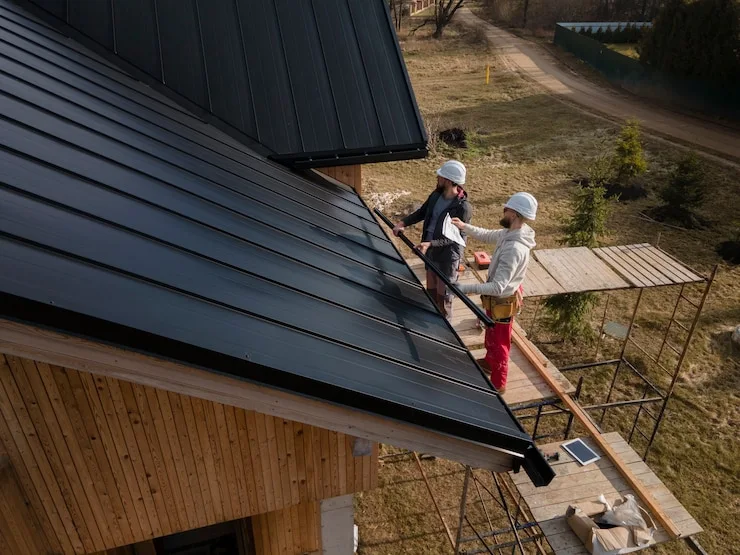What is the Best Roof Material For Solar Panels?
If you’re considering installing solar panels at home, consider placing them on your roof. While putting solar panels on the ground is also a good idea, most folks don’t have enough space in their yard for that. That’s why roof-mounted panels are so common. But before you dive in and invest in a roof-mounted system, you need to make sure your roof is up to the task.
So, how do you determine if your roof is appropriate? Here’s a helpful manual to assist you.
What Type of Roof is Best for Solar Panels?

When people consider getting solar panels, they often wonder if their house can handle them. Luckily, most roofs can support a solar power setup at home. Here are some key factors that determine if your roof is a good fit for solar energy:
Orientation and Pitch
Which direction should solar panels face? The orientation of your roof, or which way it faces, plays a significant role in how well solar panels perform. In North America, the ideal orientation for solar panels is due South. Panels get the most sunlight exposure when facing this way, resulting in maximum energy production.
But what if your roof doesn’t face South? Don’t worry too much. Many roofs face East or West and lose only 10-20% of their energy generation capacity. If your roof doesn’t face the ideal direction, talk to a qualified solar installer to explore your options.
Now, let’s talk about pitch. The slope or “pitch” of your roof is also significant for solar panels. While not as critical as orientation, pitch influences how much energy your system can produce. The best roof pitch for solar panels is generally between 30 to 40 degrees.
If your roof is too steep, installation can be tricky and limit your panel’s performance. You will need additional racking if you are setting up solar panels on a level roof. This racking is necessary to tilt the panels to the correct angle for maximum sunlight exposure.
The Roof’s Age
Technology improvements have made solar panel systems more efficient. However, the age of your roof still affects its performance. Asphalt shingle roofs typically have a lifespan of around 20 years, whereas slate roof or metal roofs can endure for over 40 years.
Considering this, it’s not wise to install a new solar system on a roof nearing the end of its lifespan. It is better to replace the roof first and install the solar panels afterward. This ensures you build your solar investment on a sturdy and long-lasting foundation.
Hours of Shade
Solar panels can generate power even on cloudy days and at night or in partial shade, but they perform best in direct sunlight. The ideal roof for solar panels gets ample sunlight and has minimal shading throughout the day.
Fortunately, solar systems are adaptable. A skilled solar installer can often find solutions if your roof doesn’t get ideal sunlight. One easy way to boost the performance of your solar panels is to trim branches or remove trees near your roof. This will allow more sunlight to reach your panels, enhancing their efficiency.
The Material of Your Roof
What is the Best Roof Material For Solar Panels? The Material of Your Roof When considering a roofing material for solar panels, there are several options to explore. However, not all choices are equally compatible with solar installation. Certain materials outperform others in this regard.
Composite shingles are the top choice for installing solar arrays on roofs because they are easy to install. Mounting panels on composite shingles typically involve straightforward flashing and mounting procedures.
Finding a solar specialist willing to work on roofs made of various materials may be challenging. These materials include tiles, wooden shake shingles, tiled roofs, clay, slate, and terracotta tiles. They are delicate and prone to breakage, leading installers to hesitate in working with them.
Sometimes, experts suggest removing the tiles or shingles under the solar panels and putting in new materials instead. This approach ensures that the panels cover these areas, maintaining the roof’s appearance and structural integrity. Additionally, it streamlines the installation process for home solar energy systems.
When installing metal or tar and gravel roofs, the installation process must be considered carefully. Proper installation techniques must be employed to prevent water leakage and ensure the effectiveness of the solar energy system.
Square Footage
The size of your roof directly influences the solar panel system you can install. Typically, residential solar panel systems are around 5 kilowatts, equivalent to approximately 20 panels rated at 250 watts each. As a rule of thumb, every kilowatt of your system requires at least 100 square feet of roof space.
When planning for solar panels, it’s important to consider skylights and uneven roof lines. These features can limit the available space for installation, even on a large roof.
Ready to begin designing your roof-mounted solar array? Let’s start!
Ready to start designing your roof-mounted solar array? Checking if your roof can support solar panels is a crucial first step. Our team is available to assist you with this process. Solar Earth is a leading solar company in Santa Barbara, California, with more than 15 years of experience. Our solar panel installation projects reduce your energy bills and enhance your property’s value. Opting for solar panels for your home or business is a sustainable choice that contributes to preserving our planet.
If you’re considering a residential solar panel system, don’t hesitate to contact our Solar energy consultants. We offer free estimates, customized designs, expert installation services, and more! Contact us today to start your solar journey.
Contact Our Friendly, Knowledgeable Staff
Solar Earth Inc., with expertise and certifications, empowers your home for enhanced energy generation. Contact us today to transform your home into a sustainable, long-term renewable energy source.
